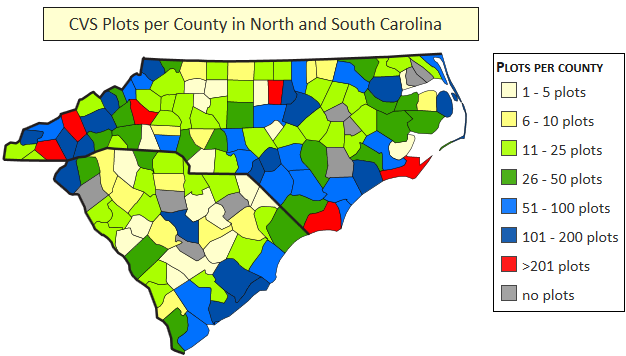Pulse !
Bootcamp for Botanists -- Botanical Woodstock -- Extreme Botany
Call it what you will, there is nothing like Pulse.
The annual "pulses" of Carolina Vegetation Survey have become established as special events for those interested in the natural history of the Carolinas. We sample a wide variety of natural communities in areas well known for their biological diversity. Many of these areas are not readily accessible without special arrangements with landowners/managers. This is an ideal way to see new and exciting areas, meet others interested in botany and ecology, and to share knowledge and experience.
Pulse 2018 --No plans yet, but watch here
For more information, download the 2015 invitation
To get a feel for pulse, look at our Photos, download our Slideshow (23M), or just join us for a few days.
At Carolina Vegetation Survey pulses core scientists and volunteers from across the region study a portion of the Carolinas intensively. All persons interested in vegetation and/or field botany are invited to participate for as many days as is convenient. The entire event typically lasts eight days. Any level of experience is appropriate; the only requirement is that you bring your enthusiasm for field work. Lodging is provided, and sometime even a t-shirt can be had.
Data collection methods are standardized and are now widely employed across the Southeast. In addition to increasing our understanding of the vegetation of the Carolinas, data collected by the Survey are used for inventory, monitoring, and targeting restoration of the biodivdersity of the region. Data are are available to researchers, government agencies, and conservation organization upon request.

Past pulse events
Click on "Map" below to see locations of plots for a pulse. Plots are color-coded by team. Plot number and most similar established National Vegetation Classification (NVC) community type can be seen by clicking on the marker. Zoom in to see the multiple plots in one location.
Click on "Plots and Communites"
to see plot assignments to NVC community types. Note that a plot can be assigned to more than one community, especially if the fit is low. The number of plots with low fit demonstrates the importance of these plots for improving the NVC.
- 2015 Inner Coastal Plan of South Carolina
[Map: VegBank] [Plots and Communities] - 2014 Murphy2Manteo -- Undersampled community types
[Map: VegBank] [Plots and Communities] - 2013B West-central Piedmont.
[Map: VegBank] [Plots and Communities]
- 2013A Asheboro region and the NC Zoo.
[Map:VegBank] [Plots and Communities]
- 2012B Central South Carolina Piedmont
[Map:VegBank] [Plots and Communities]
- 2012A Central Coastal Plain of North Carolina.
[Map:VegBank] [Plots and Communities]
- 2011B The North Carolina Triangle
[Map:VegBank] [Plots and Communities]
- 2011A The South Carolina Southwest Piedmont
[Map:VegBank] [Plots and Communities]
- 2010B The Western North Carolina Mountains
- 2010A North-Central Piedmont
- 2009F Lacunae of the Maritime Fringe
[Map:VegBank] [Plots and Communities]
- 2009E Piedmont non-alluvial wetlands
[Map:VegBank]
- 2009D Coastal Plain Brownwater River Vegetation
[Map:VegBank]
- 2009C South Carolina Coastal Fringe
[Map:VegBank] [Plots and Communities]
- 2009B South-Central Piedmont
- 2009A Pamlimarle Peninsula & Pamlico River-South
- 2008C Piedmont Riparian Vegetation of the Catawba River Basin [Map: VegBank] [Plots and Communities]
- 2008B Upper Tar River & Meherrin/Chowan Rivers
- 2008A Columbus County NC & Horry County SC
- 2007C Piedmont Riparian Vegetation of the Neuse-Tar River Basin [Report]
- 2007B Croatan & Down East
- 2007A Western sandhills
- 2006D Montane non-alluvial wetlands
- 2006C Piedmont riparian vegetation of the Cape Fear Basin [Report]
- 2006B North of the Albemarle
- 2006A Bladen Lakes Region
- 2005B SE North Carolina Coastal Plain (Brunswick County)
- 2005A Lower Santee River Country, SC
- 2004B Northeastern Coastal Plain - Windsor
- 2004A Southeastern Coastal Plain - Pender and adjacent counties
- 2003B Forests and glades of the Rock Hill - Charlotte - Gastonia Area
- 2003A The Outer Banks and Mainland Dare County
- 2002D Mafic vegetation of Wadakoe Mountain
- 2002C Northwest Piedmont of North Carolina
- 2002B Bird Island
- 2002A Piedmont Flat Rocks, NC
- 2001B South Mountains and adjacent Blue Ridge Escarpment, NC
- 2001A Shrubland, grassland and marsh vegetation of the SC coastal fringe.
- 2000B Gorges State Park and vicinity
- 2000A Pinelands and Maritime Forests of the SC Coastal Plain
- 1999B The Amphibolite Mountains of Ashe & Watauga Counties, NC
- 1999A Calcareous Forests of the NC Coastal Plain
- 1998B Hickory Nut Gorge and the Hot Springs Window, NC
- 1998A Calcareous forests of the SC Coastal Plain
- 1997 Highlands
- 1996 Nantahala Mountains
- 1995 Grandfather Mountain & Roan Mountain.
- 1994 Uwharrie Mountains
- 1993 Fire-maintained pinelands - NC Coastal Plain: Brunswick, Columbus & Robeson Counties.
- 1992 Fire-maintained pinelands- NC Coastal Plain: Pender and Bladen Counties.
- 1991 Fire-maintained pinelands - NC Coastal Plain: Croatan NF and Camp Lejeune.
- 1990 Fire-maintained pinelands - NC Sandhills.
- 1989 Fire-maintained pinelands - NC Sandhills
- 1988 Maritime Forests